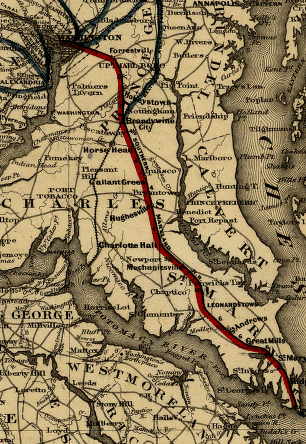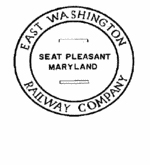Washington, Brandywine & Point Lookout Railroad
| Washington, Brandywine & Point Lookout Railroad | |
|---|---|
 The Washington, Brandywine & Point Lookout Railroad, then the Southern Maryland Railroad, as planned | |
| Locale | Washington, DC to Seat Pleasant, Maryland and Brandywine, Maryland to Patuxent River, Maryland |
| Dates of operation | 1881 – July, 1954 |
| Track gauge | 4 ft 8½ in (1435 mm) (standard gauge) |
| Headquarters | |
The Washington, Brandywine & Point Lookout Railroad (WB&PL), now defunct, was an American railroad of southern Maryland and Washington, DC built in the 19th century. The troubled WB&PL, originally the Southern Maryland Railroad operated in and out of bankruptcy and changed its name numerous times. It consisted of two pieces, one serving Washington, D.C. and Seat Pleasant, MD and the other, a single track line connecting Patuxent River, MD to the Pennsylvania Railroad. Despite numerous problems, the railroad was able to survive for 73 years before shutting down in 1954. The Washington, DC section was absorbed by the Chesapeake Beach Railroad and later became the East Washington Railroad, which stayed in business until 1978. Parts of the right-of-way are now used for homes, a rail spur and a rail trail.
Contents
- 1 History
- 1.1 Origins
- 1.2 The East Washington Line
- 1.3 Washington City and Point Lookout Railroad
- 1.4 Washington & Potomac Railroad
- 1.5 Washington, Potomac & Chesapeake Railway
- 1.6 Washington, Brandywine & Point Lookout Railroad
- 1.7 Navy Control
- 1.8 Pennsylvania Railroad Control
- 1.9 End of the Line
- 1.10 The East Washington Railway
- 2 Stations on the Line
- 3 Surviving Landmarks
- 4 References
- 5 External links
History
Origins
The Southern Maryland Railroad (SMR) was incorporated on March 20, 1868 “for the purpose of constructing, maintaining, and working a railroad from some point in [[Prince George’s County]] to Point Lookout.” [1] A commission was appointed, money was raised, and an engineer was hired to build an eighty mile rail line.
The East Washington Line
In 1871, the SMR began construction on its East Washington line by laying its tracks close to the Old Bladensburg-Piscataway Road and building a station near the Sheriff farm. Construction began at Chesapeake Junction and two miles of line were built connecting with the Baltimore & Ohio Railroad at Deanwood.[2]
Washington City and Point Lookout Railroad
In 1872, a competitor railroad, the Washington City and Point Lookout Railroad was incorporated and authorized to run trains between Washington, DC and Point Lookout with connecting steamers to Norfolk, Virginia. They began building a line immediately parallel and adjacent to the SMR.[3] In 1876 the SMR was investigated for defrauding the state of Maryland, the sole stock holder in the company, and went bankrupt without running a single train.[4]
In 1878 the WC&PL was authorized to purchase the SMR but never did.[5]
Construction was later restarted in Brandywine where the SMR connected with the Baltimore and Potomac Railroad (later the Pope's Creek branch of the Pennsylvania Railroad) and was built in a southeasterly direction. It wasn't until 1881 that the first train was run serving Charlotte Hall and Mechanicsville. By 1884, twenty-one miles had been built and fifty miles graded.[6]
Washington & Potomac Railroad
The line went into its next bankruptcy in 1886 and emerged on April 1, 1886 as the Washington & Potomac Railroad (W&P). The line wouldn't run farther south than Mechanicsville until the U.S. Navy took over during World War II. The East Washington line went into receivership and was taken over, illegally, by the Chesapeake Beach Railroad.
In 1894, the W&P merged with the WC&PL, which was by then in receivership.[3]
Washington, Potomac & Chesapeake Railway
In 1900, the line went through another bankruptcy and emerged on July 24, 1901 as the Washington, Potomac & Chesapeake Railway.[7] The WP&C had a contentious relationship with the state. In 1910 they were ordered to run two trains a day - up from one and to drop their prices.[8] The line had trouble fulfilling its obligations and in 1914 the state of Maryland threatened to withdraw their charter.[9]
Washington, Brandywine & Point Lookout Railroad
At the end of 1917 the line again found itself in bankruptcy and was very nearly scrapped due to the high price of scrap metal during World War I. In 1918, the state of Maryland attempted to have the U.S. government take over control of the railroad.[10] Farmers in the area were able to purchase the line from a salvage firm and in June of 1918 the line began running again, this time under the name of the Washington, Brandywine & Point Lookout Railroad.
In the 1930's, revenues were dropping due to increased competition from the automobile and the line probably would have been gone for good, except for the intervention of World War II.
In June of 1942, the US Navy took over the line and extended it to the Patuxent River Naval Air Station. The name was changed again, this time to the more accurate Brandywine and Cedar Point Railroad. As late as the mid-1950's the Navy was still operating the line. The Navy operated an "accommodation" train that connected with the Pennsylvania Railroad in Brandywine until the PRR stopped passenger trains on the Pope's Creek Line in 1949.
Pennsylvania Railroad Control
In 1953 the railroad fell into disrepair. The extensive maintenance costs were too much to keep it in business and the Brandywine and Cedar Point was closed in 1954. The last regular run was made in July of 1954 from the Naval Air Station to Hollywood, MD. Through the late 1950s/early 1960s, PRR trains used the line to deliver aviation fuel to the base. However, when fuel started coming in by barge, the importance of the line dwindled.
End of the Line
When train operation ceased, the line was offered for sale by the GSA but there were no takers. Then, on June 26, 1970 the St. Mary's County Commissioners purchased 28 miles of the abandoned right of way from Hughesville, Maryland to Patuxent River, Maryland.[11] The tracks were removed in the mid-1970's.
The East Washington Railway
The East Washington survived for 40 years after the Chesapeake Beach Railroad stopped running in 1935. Its main customers were a liquor company, a cement company and PEPCO, the local power company. PEPCO needed coal delivered to its Benning Road Plant from Chesapeake Junction, the interchange with the Baltimore and Ohio Railroad. In 1975 the power plant converted to oil, and shortly thereafter the cement company moved. In 1976, the railroad, which by then included four employees and a single Whitcomb ceased operations. [12]
Stations on the Line
Original line pre-1942
- Brandywine
- Cederville
- Woodville
- Gallant Green
- Hughesville
- Oaks
- Charlotte Hall
- New Market
- Mechanicsville (original end-of-the-line)
In 1942, the US Government took over operations of the railroad and continued to make deliveries to stops on the original route. In addition the line was extended and these stops added.
- Oakville
- Laurel Grove
- Forrest Hall
- Hillville
- Hollywood
- California
- USN Pax River
After 1954-Pennsylvania Railroad operation
When the USN excessed the line in 1954 and the PRR took over operations, they delivered and took away freight shipments and occasionally carried a passenger car (USN) or caboose (also USN) for special movements to/from the Brandywine Junction which became a Department of Defense Warehouse and shipping point until it was destroyed by fire. The Brandywine terminal was US Government property and was maintained by Public Works personnel from Patuxent River. The terminal was turned over to the Air Force just before it burned.
Surviving Landmarks
- Trackage that runs from Brandywine to Hughesville, MD where it connects to a spur to the Chalk Point generating station.
- From Hughesville to the Patuxent River Naval Station, the railroad's right-of-way is being used to create the 28 mile long Three Notch Trail. The first mile of which opened on June 3, 2006.
- Mile Posts, MP13 & W
References
- ↑ Proceedings and Acts of the General Assembly of Maryland (March 30, 1868).
- ↑ Ward 7 Plan.
- ↑ 3.0 3.1 Maryland Session Laws, 1894 (1894).
- ↑ Proceedings and Acts of the Maryland General Assembly, 1876 (1876).
- ↑ Maryland Session Laws, 1884 (1884).
- ↑ Maryland Session Laws, 1878 (1878).
- ↑ Chesapeake Beach R Co v. Washington P & C R Co, 199 U.S. 247 (1905).
- ↑ Session Laws of Maryland, 1910 (1910).
- ↑ Session Laws of Maryland, 1914 (1914).
- ↑ Maryland Session Laws, 1918 (1918).
- ↑ Amendments to Senate Bill 256 (1998).
- ↑ Lustig, David (April 1996). Four Railroaders and a Whitcomb.
External links
- Southern Maryland Railroad Map
- Photos of railroad's artifacts
- Three Notch Trail
- Map showing the Washington City and Point Lookout Railroad and its connections in 1888
- Map and Schedule of the East Washington Railway
| List of United States railroads by political division | |
|---|---|
| Alabama · Alaska · Arizona · Arkansas · California · Colorado · Connecticut · Delaware · Florida · Georgia · Hawaii · Idaho · Illinois · Indiana · Iowa · Kansas · Kentucky · Louisiana · Maine · Maryland · Massachusetts · Michigan · Minnesota · Mississippi · Missouri · Montana · Nebraska · Nevada · New Hampshire · New Jersey · New Mexico · New York · North Carolina · North Dakota · Ohio · Oklahoma · Oregon · Pennsylvania · Rhode Island · South Carolina · South Dakota · Tennessee · Texas · Utah · Vermont · Virginia · Washington · West Virginia · Wisconsin · Wyoming | |
| District of Columbia · Puerto Rico | |
|
| |
| See also: List of defunct United States railroads | |

